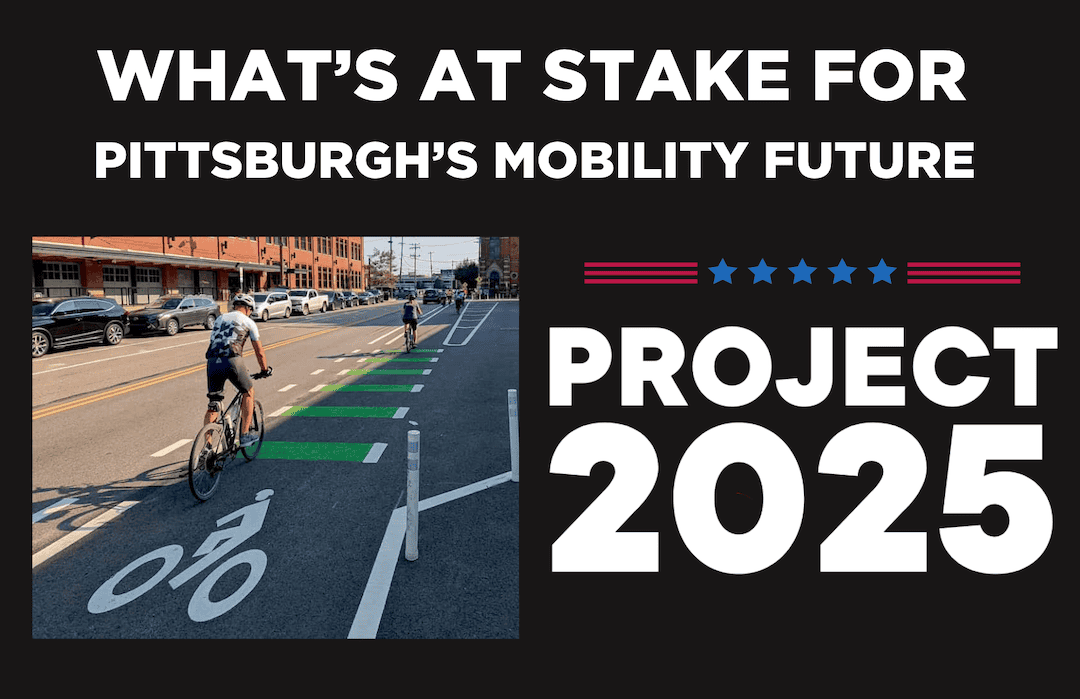We at BikePGH have a simple goal: making our city better for everyone who bikes and walks. But Project 2025 from the Heritage Foundation calls for the rolling back of policies and federal funding that makes this work possible. In short, it could undo a lot of the progress we’ve made toward safer, more connected streets.

A lot has been made of Project 2025’s other extreme positions on remaking the federal government, but not much has been written about what this would mean for transportation policy and funding. Think of it as a blueprint for dismantling most of what makes modern city transportation work. They want to:
- Focus only on highways and ditch support for transit and local streets
- Cut federal funding for bike lanes and pedestrian infrastructure
- Drop fuel efficiency requirements
- Abandon Vision Zero
Project 2025 basically wants to pull federal support for public transit agencies. They’re even pushing to reform (read: eliminate) the Capital Investment Grants program that helps build new light rail and rapid bus lines.
Here’s why that matters: every successful bike and pedestrian-friendly city has solid public transit. They work together – it’s not just about bikes or just about buses, it’s about giving people real choices for getting around. When you cut one piece, the whole system suffers.
For Pittsburgh specifically, this could mean saying goodbye to federal funding like the Congestion Mitigation Air Quality program that launched and is expanding POGOH bike share, losing support for new bike lanes and safer streets, and struggling to maintain and expand our transit system.
Project 2025 treats Vision Zero like it’s just more red tape, when it’s actually about keeping people alive. We’re talking about more than 40,000 Americans who die in traffic crashes every year, just shy of the annual number killed by guns.
Right now, Pittsburgh, Allegheny County, and PennDOT are using federal funding from the federal Safe Streets and Roads for All program to identify and ultimately fix more than a dozen dangerous corridors. Project 2025 would pull the plug on efforts like these, essentially saying that saving lives isn’t a federal priority.
They’re also trying to roll back fuel economy standards to 2020 levels. Think about that – while the rest of the world is moving forward on efficiency and climate action, they want to go backward. This isn’t just about gas prices; it’s about air quality in our neighborhoods, affordable transportation and our city and county’s contribution to addressing climate change.
What This Means for Pittsburgh
If Project 2025 gets its way, there would be less money for bike lanes, trails, sidewalks, and buses when we need them most. It would be harder for Pittsburgh to attract new residents and businesses because nobody wants to live in a city where you can’t get around safely outside of a car. Our streets and roads would be more dangerous for everyone – cyclists, pedestrians, and yes, drivers too. And it would put a larger burden on local municipalities to come up with funds to remake our streets.
We’re working toward a future where everyone – regardless of how they choose to get around – can safely use our streets. But we can’t get there if these regressive Project 2025 policies take hold.
This isn’t just about bikes or buses or cars – it’s about building a Pittsburgh that works for everyone. And that means having choices, not limiting them. Whether you’re a daily bike commuter, a weekend bicyclist, someone who relies on the bus, or even if you mainly drive, these changes would make getting around our city more difficult and less safe.
Read the Project 2025 chapter on transportation here (Chapter 19, Pages 619-639)
